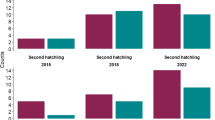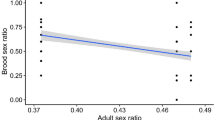Abstract
Timing of birth and food availability may select for biased offspring sex ratios when they differentially affect the reproductive value of male and female young. Here we show that early hatching date enhances more the probability of male Eurasian kestrels (Falco tinnunculus) to breed as one-year-old than that of females in a Finnish population. This rarely documented phenomenon has been previously observed in a kestrel population in the Netherlands. As kestrels in the Finnish population are migratory, our results refute the hypothesis that early-fledged males would have an advantage for early breeding only in resident populations. Contrary to the predictions, the Finnish population showed no change in brood sex ratio during the breeding season in a long-term data from 8years. As far as we know, this is the first demonstration that biased sex allocation may not occur even when it would appear to be adaptive. This result is different from the Dutch kestrel population, in which the season began with a bias towards males and ended with a bias in favour of females. We suggest that high inter-annual variation in food abundance in Finland might reduce selection for a sex ratio trend.
Similar content being viewed by others
References
Aparicio, J.M. and Cordero, P.J. (2001) The effects of the minimum threshold condition for breeding on offspring sex ratio in the lesser kestrel. Evolution 55, 1188–1197.
Appleby, B.M., Petty, S.J., Blakey, K., Rainey, P. and MacDonald, DW (1997) Does variation of sex ratio enhance reproductive success of offspring in tawny owls (Strix aluco)? Proc. Roy. Soc. Lond B 264, 1111–1116.
Arroyo, B.E. (2002) Fledgling sex ratio variation and future reproduction probability in Montagu’s harrier, Circus pygargus. Behav. Ecol. Sociobiol. 52, 109–116.
Badyaev, A.V., Hill, G.E., Beck, M.L., Derwan, A.A., Duckworth, R.A., Mcgraw, K.J., Nolan, P.M. and Whittingham, L.A. (2002) Sex-Biased hatching order and adaptive population divergence in a Passerine Bird. Science 295, 316–318.
Brommer, J., Karell, P., Pihlaja, T., Painter, J.N., Primmer, C.R., Pietiäinen, H. (2003) Ural owl sex allocation and parental investment under poor food conditions. Oecologia 137, 140–147.
Byholm, P., Brommer, J.E. and Saurola, P. (2002a) Scale and seasonal sex-ratio trends in northern goshawk Accipiter gentilis broods. J. Avian Biol. 33, 399–406.
Byholm, P., Ranta, E., Kaitala, V., Linden, H., Saurola, P. and Wikman, M. (2002b) Resource availability and goshawk sex ratio: a large-scale ecological phenomenon. J. Anim. Ecol. 71, 994–1001.
Charnov, E.L. (1982). The Theory of Sex Allocation. Princeton University Press, Princeton.
Cockburn, A., Legge, S. and Double, M.C. (2002) Sex ratios in birds and mammals: can the hypotheses be disentangled? In I.W.C. Hardy (ed.) Sex Ratios: Concepts and Methods. Cambridge University Press, Cambridge, pp. 266–288.
Cordero, P.J., Vinuela, J., Aparicio, J.M. and Veiga, J.P. (2001) Seasonal variation in sex ratio and sexual egg dimorphism favouring daughters in first clutches of the spotless starling. J. Evolution. Biol. 14, 829–834.
Daan, S., Dijkstra, C. and Weissing, F.J. (1996) An evolutionary explanation for seasonal trends in avian sex ratios. Behav. Ecol. 7, 426–430.
Dijkstra, C., Daan, S. and Buker, J.B. (1990) Adaptive seasonal variation in the sex ratio of kestrel broods. Funct. Ecol. 4, 143–147.
Dzus, E.H., Bortolotti, G.R. and Gerrard, J.M. (1996) Does sex-biased hatching order in bald eagles vary with food resources? Ecoscience 3, 252–258.
Fargallo, J.A., Laaksonen, T., Pöyri, V. and Korpimäki, E. (2002) Inter-sexual differences in the immune response of Eurasian kestrel nestlings under food shortage. Ecol. Lett. 5, 95–101.
Fiala, K.L. (1980) On estimating the primary sex ratio from incomplete data. Am. Nat. 115, 442–444.
Forsman, D. (1999) The Raptors of Europe and the Middle East. A Handbook of Field Identification. T and AD Poyser, London.
Frank, S.A. (1990) Sex allocation theory for birds and mammals. Ann. Rev. Ecol. Syst. 21, 13–55.
Fridolfsson, A.-K. and Ellegren, H. (1999) A simple and universal method for molecular sexing of non-ratite birds. J. Avian Biol. 30, 116–121.
Hansson, L. and Henttonen, H. (1988) Rodent dynamics as community processes. Trends Ecol. Evol. 3, 195–200.
Hardy, I.C.W. (2002) Sex Ratios: Concepts and Methods. Cambridge University Press, Cambridge.
Hasselquist, D. and Kempenaers, B. (2002) Parental care and adaptive brood sex ratio manipulation in birds. Philos. Trans. Roy. Soc. Lond. B. 357, 363–372.
Hewison, M.A.J. and Gaillard, J.-M. (1999) Successful sons or advantaged daughters? The Trivers-Willard model and sex-biased maternal investment in ungulates. Trends Ecol. Evol. 14, 229–234.
Hipkiss, T. (2002) Brood sex ratio and sex differences in Tengmalm’s owl (Aegolius funereus). Ph.D. Thesis, Ecology and Environmental Science, University of Umeå, Sweden.
Jönsson, K.I., Wiehn, J. and Korpimäki, E. (1999) Body reserves and unpredictable breeding conditions in the Eurasian kestrel, Falco tinnunculus. Ecoscience 6, 406–414.
Komdeur, J. and Pen, I. (2002) Adaptive sex allocation in birds: the complexities of linking theory and practice. Philos. Trans. Roy. Soc. Lond. B. 357, 373–380.
Komdeur, J., Daan, S., Tinbergen, J. and Mateman, C. (1997) Extreme adaptive modification in sex ratio of the Seychelles warbler’s eggs. Nature 385, 522–525.
Komdeur, J., Magrath, M.J.L. and Krackow, S. (2002) Pre-ovulation control of hatchling sex ratio in the Seychelles warbler. Proc. Roy. Soc. Lond. B 269, 1067–1072.
Korpimäki, E. (1984) Population dynamics of birds of prey in relation to fluctuations in small mammal populations in western Finland. Annales Zoologici Fennici 21, 287–293.
Korpimäki, E. (1985) Diet of the Kestrel Falco tinnunculus in the breeding season. Ornis Fennica 62, 130–137.
Korpimäki, E. (1986) Diet variation, hunting habitat and reproductive output of the Kestrel Falco tinnunculus in the light of the optimal diet theory. Ornis Fennica 63, 84–90.
Korpimäki, E. and Norrdahl, K. (1991) Numerical and functional responses of Kestrels, Shorteared Owls, and Long-eared Owls to vole densities. Ecology 72, 814–826.
Korpimäki, E. and Wiehn, J. (1998) Clutch size of kestrels: seasonal decline and experimental evidence for food limitation under fluctuating food conditions. Oikos 83, 259–272.
Korpimäki, E., May, C.A., Parkin, D.T., Wetton, J.H. and Wiehn, J. (2000) Environmental-and parental condition-related variation in sex ratio of kestrel broods. J. Avian Biol. 31, 128–134.
Korpimäki, E., Norrdahl, K., Klemola, T., Pettersen, T. and Stenseth, N.C. (2002) Dynamic effects of predators on cyclic voles: field experimentation and model extrapolation. Proc. Roy. Soc. Lond. B. 269, 991–997.
Krebs, E.A., Green, D.J., Double, M.C. and Griffiths, R. (2002) Laying date and laying sequence influence the sex ratio of crimson rosella broods. Behav. Ecol. Sociobiol. 51, 447–454.
Kruuk, L.E.B., Clutton-Brock, T.H., Albon, S.D., Pemberton, J.M. and Guinness, F.E. (1999) Population density affects sex ratio variation in red deer. Nature 399, 459–461.
Leimar, O. (1996) Life-history analysis of the Trivers and Willard sex-ratio problem. Behav. Ecol. 7, 316–325.
Leroux, A. and Bretagnolle, V. (1996) Sex ratio variations in broods of Montagu’s Harriers Circus pygargus. J. Avian Biol. 27, 63–69.
Lindström, J., Coulson, T., Kruuk, L., Forchhammer, M.C., Coltman, D.W. and Clutton-Brock, T. (2002) Sex-ratio variation in Soay sheep. Behav. Ecol. Sociobiol. 53, 25–30.
Masman, D., Daan, S. and Beldhuis, J.A. (1988) Ecological energetics of the kestrel: daily energy expenditure throughout the year based on time-energy budget, food intake and doubly labelled water method. Ardea 76, 64–81.
Mikkola, H. (1983) Owls of Europe. Poyser, Calton.
Myers, J.H. (1978) Sex ratio adjustment under food stress - maximisation of quality and numbers of offspring. Am. Nat. 112, 381–388.
Nager, R.G., Monaghan, P., Griffiths, R., Houston, D.C. and Dawson, R. (1999) Experimental demonstration that offspring sex ratio varies with maternal condition. Proc. Nat. Acad. Sci. USA 96, 570–573.
Palokangas, P., Alatalo, R.V. and Korpimäki, E. (1992) Female choice in the kestrel under different availability of mating options. Anim. Behav. 43, 659–665.
Pen, I. (2000) Sex allocation in a life-history context. Ph.D. Thesis, Rijksuniversiteit Groningen, The Netherlands, pp. 207–218.
Pen, I., Weissing, F.J. and Daan, S. (1999) Seasonal sex ratio trend in the European kestrel: An evolutionarily stable strategy analysis. Am. Nat. 153, 384–397.
Post, E., Forchhammer, M.C., Stenseth, N.C. and Langvatn, R. (1999) Extrinsic modification of vertebrate sex ratios by climatic variation. Am. Nat. 154, 194–204.
Radford, A.N. and Blakey, J.K. (2000) Is variation in brood sex ratios adaptive in the great tit (Parus major)? Behav. Ecol. 11, 294–298.
Risch, M. and Brinkhof, M.W.G. (2002) Sex ratios of Sparrowhawk (Accipiter nisus) broods: the importance of age in males. Ornis Fennica 79, 49–59.
Sheldon, B.C., Andersson, S., Griffith, S.C., Örnborg, J. and Sendecka, J. (1999) Ultraviolet colour variation influences blue tit sex ratios. Nature 402, 874–877.
Smallwood, P.D. and Smallwood, J.A. (1998) Seasonal shifts in sex ratios of fledgling American kestrels (Falco sparverius paulus): The Early Bird Hypothesis. Evol. Ecol. 12, 839–853.
Tolonen, P. and Korpimäki, E. (1994) Determinants of parental effort: a behavioural study in the European kestrel, Falco tinnunculus. Behav. Ecol. Sociobiol. 35, 355–362.
Trivers, R.L. and Willard, D.E. (1973) Natural selection of parental ability to vary the sex ratio of offspring. Science 179, 90–92.
Village, A. (1990) The Kestrel. Poyser, London.
West, S.A. and Sheldon, B.C. (2002) Constraints in the evolution of sex ratio adjustment. Science 295, 1685–1688.
Wetton, J.H., Burke, T., Parkin, D.T. and Cairns, E. (1995) Single locus DNA fingerprinting reveals that male reproductive success increases with age through extra-pair paternity in the house sparrow (Passer domesticus). Proc. Roy. Soc. Lond B. 260, 91–98.
Wiebe, K.L. and Bortolotti, G.R. (1992) Facultative sex ratio manipulations in American kestrels. Behav. Ecol. Sociobiol. 30, 379–386.
Wiehn, J. and Korpimäki, E. (1997) Food limitation on brood size: experimental evidence in the Eurasian kestrel. Ecology 78, 2043–2050.
Wilson, K. and Hardy, I.C.W. (2002) Statistical analysis of sex ratios: an introduction. In I.C.W. Hardy (ed.) Sex Ratios: Concepts and Methods. Cambridge University Press, Cambridge, pp. 48–92.
Zijlstra, M., Daan, S. and Bruinenberg-Rinsma, J. (1992) Seasonal variation in the sex ratio of marsh harrier Circus aeruginosus broods. Function. Ecol. 6, 553–559.
Author information
Authors and Affiliations
Rights and permissions
About this article
Cite this article
Laaksonen, T., Lyytinen, S. & Korpimäki, E. Sex-Specific Recruitment and Brood Sex Ratios of Eurasian Kestrels in a Seasonally and Annually Fluctuating Northern Environment. Evol Ecol 18, 215–230 (2004). https://doi.org/10.1023/B:EVEC.0000035081.91292.17
Issue Date:
DOI: https://doi.org/10.1023/B:EVEC.0000035081.91292.17




